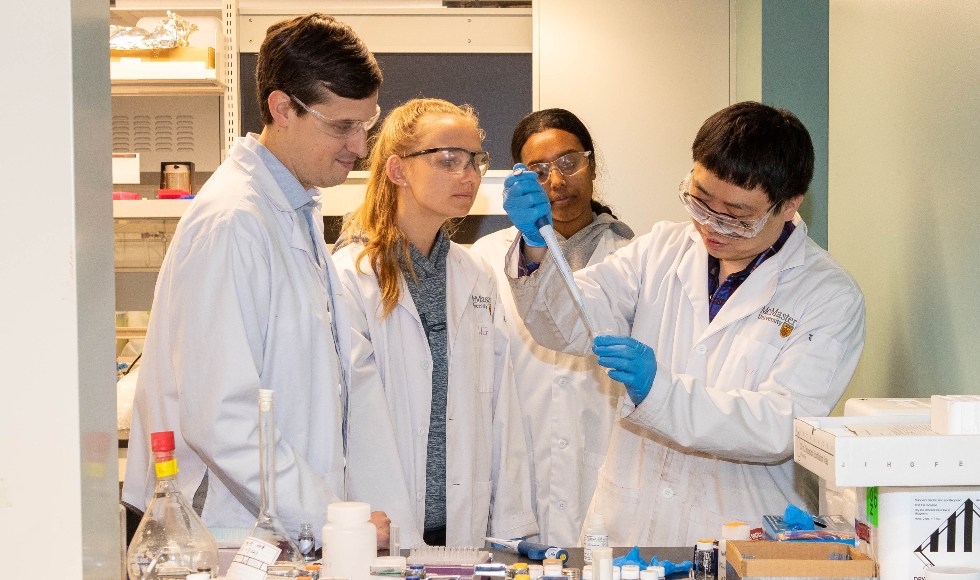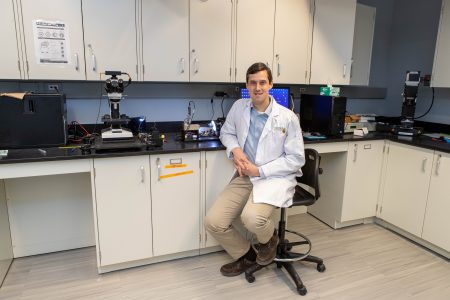Students + postdocs + faculty + industry = solutions to big challenges

Photo by Georgia Kirkos
BY Sara Laux
September 26, 2019
Hydrogels – polymer networks that can hold many times their own weight in water – are what make soft contacts soft, diapers absorbent and Jell-O jiggle.
Developing hydrogels that respond to environmental changes – disease, for example, or a magnetic field – is what the Laboratory for Engineered Smart Materials does.
The lab, supervised by chemical engineering professor Todd Hoare, concentrates primarily on hydrogels for drug delivery, tissue engineering and biosensing, with applications ranging from arthritis treatment to agriculture.
Oh, and they work on diapers, too. (It’s surprisingly complicated to get the polymers in Huggies to absorb the right amount of liquid at the right speed.) In fact, industrial research is a big part of what the lab does.
Current projects with industry include work with Kimberly-Clark (the company that makes Huggies), and, among others, a recently announced partnership between the biotech company Ceapro, the Canadian Institutes of Health Research, the National Sciences and Engineering Research Council of Canada, and two other McMaster researchers to develop polymer scaffolds that could help treat idiopathic pulmonary fibrosis, as well as antibiotic-resistant infected wounds.

Hoare’s lab purposely bridges the gap between engineering and chemistry.
“More and more there are a lot of people straddling the fence right now, whether it’s physics and engineering, biochemistry and engineering, or chemistry and engineering,” he explains. “That’s where a lot of the innovation is. You’re translating some of the fundamentals that are being learned into a product that can be used.”
Because of that, the undergrads, grad students and postdocs who work in his lab have an interesting mix of academic backgrounds, including chemical engineering, biomedical engineering, chemistry, biochemistry and even neuroscience.
The diversity extends beyond academics: the lab also has researchers from seven different countries, the majority of them women.
Another aspect of Hoare’s lab that’s completely intentional is the number of undergraduate students working there: 12 at last count. With research often seen to be reserved for graduate students, Hoare points out that hiring undergrads provides them with valuable experience: assigned their own projects, they get to see what research is really like, away from the somewhat artificial environments of lab courses.
“Some leave, saying, ‘I never want to do this again,’ because research involves a lot of failure, and some people don’t like that,” he says. “A lot of them, though, catch the bug and keep going. Since I started my lab in 2008, 21 students have gone on to graduate school – and a good number of them wouldn’t have thought of that until they got into the lab and saw what it was like.”
Great to see one of our lab alumni doing great things! Now, the challenge – how to use hydrogels in nuclear power generation… https://t.co/CE6T9kVtWQ
— The Hoare Lab (@HoareLab) September 3, 2019
It’s not just the undergrads who benefit from being in the lab – their supervisors get the management experience that they’ll need once they start their careers, whether they stay in academia or move into industrial work.
Hoare’s lab is big: 29 people, including the 12 undergrads and five postdocs. They’re located in the newly renovated Arthur Bourns Building, nestled between researchers working on synthetic organic chemistry and silicone chemistry. That’s a great recipe for collaboration, says Hoare.
“We’ve worked with both researchers in ways that maybe we wouldn’t have before, because students are now sharing the same office space and talking,” he says. “A lot of the disciplines are merging, because we’re recognizing that the problems we have to solve are not simple problems, so you have to bring people from different backgrounds together to address them.”


